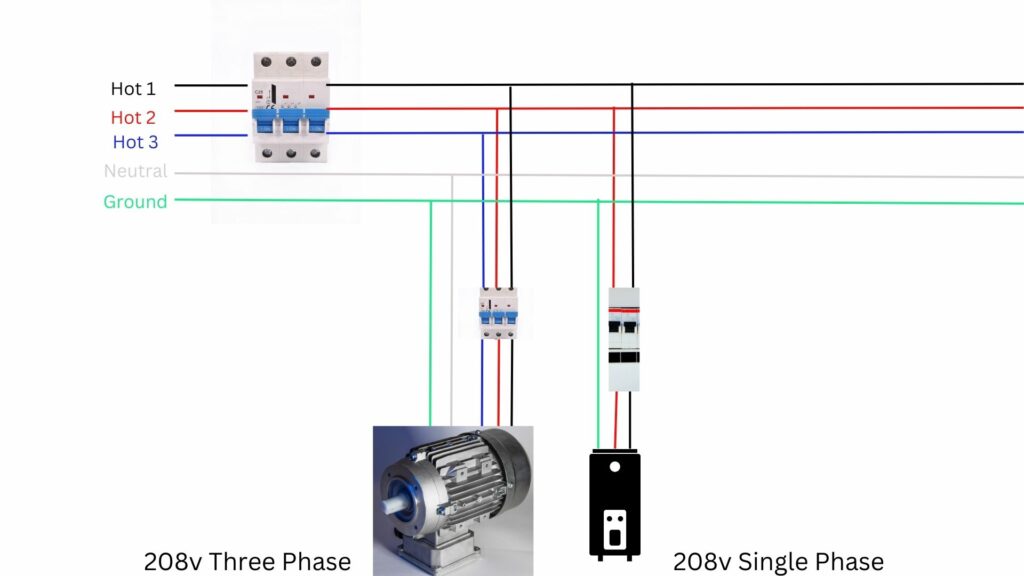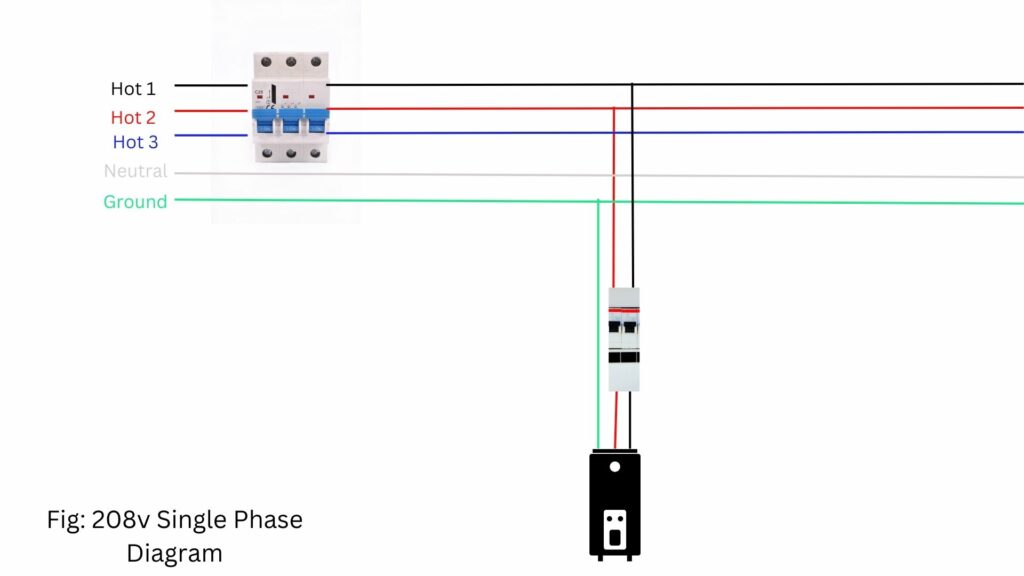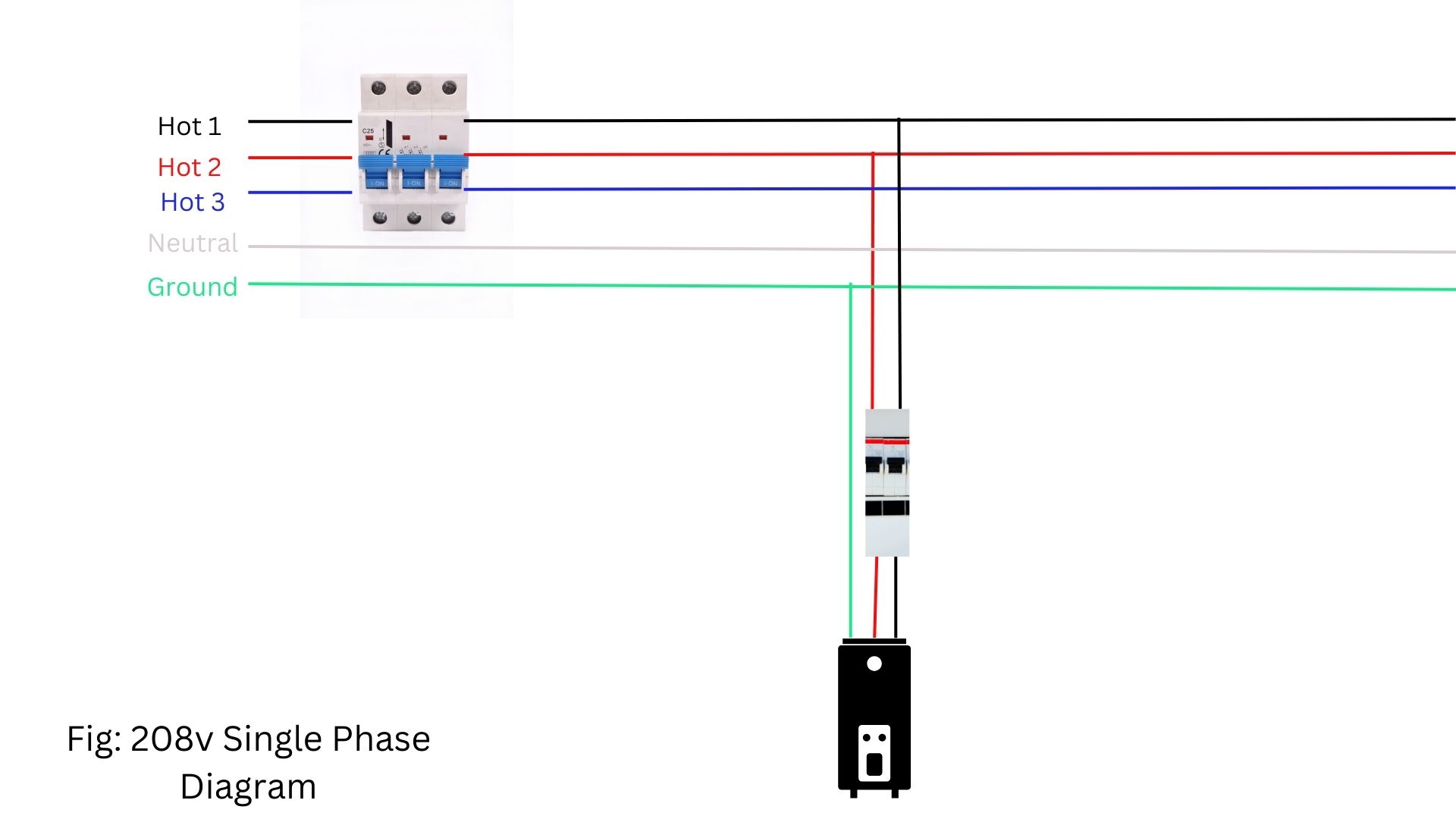If you don’t know better, you may conclude that 240V and 208V are the same. After all, they are separated by a mere 32 volts. That separation is even smaller for 220V. However, 208V and 240V couldn’t be more different from one another.
Connecting 208V power to your 240V appliances is a bad idea, especially if the power in question is three-phase. To make sense of 208V power, you need to start at the beginning. Consider the following:
1). How Electrical Distribution Works
Utility providers use higher voltages to transmit power because they want to minimize losses. They use transformers to step those voltages down when the power reaches the consumer. Residential settings in North America use single-phase 120V power.
But utility providers transmit that power via two 120V legs that combine to deliver 220 – 240V single-phase power to households with heavy-duty appliances.
How does 208V enter the picture? Utility providers distribute power in three-phase form. It only becomes single-phase when it reaches a residential setting and only after transitioning through a transformer.
However, commercial and industrial centers don’t require that sort of conversion. Their loads are heavy and utilize three-phase supplies. 208V is typically three-phase, which is why small businesses use it.
What if you had a single-phase device, but 208V three-phase power was the only option at your disposal? You can extract single-phase power from 208V three-phase if you have the correct tools (three hot wires along with a neutral and ground wire).
2). Differentiating Between Single-Phase and Three-Phase Power
Single-phase and three-phase power have distinct attributes. Singe-phase uses two wires. People call it ‘Single Phase’ because only one wire is hot. The other line is neutral. If you check your electrical box, you will see these black and white wires.
Three-phase power, which electrical companies use for long-distance transmission, uses three wires, hence the name. The transition from single to three-phase happens in those pot-shaped devices you see on utility poles. Those are transformers.
While single-phase is simplistic in its design, the inconsistent power supply makes it insufficient for factories. The fluctuations will wear single-phase motors out at a faster rate.
Additionally, even when you combine the power on a single-phase system’s 120V legs to produce 240V, it isn’t enough to accommodate the needs of commercial settings. Three-phase applications require three-phase power because it is cheaper (it uses smaller wires) and more efficient. More importantly, DIY-All-Day associates these systems with higher power loads.
3). How To Get 208V?
208V isn’t necessarily single-phase. The concept sounds complicated. But the following should simplify things:
- As you now understand, power companies use three legs to transmit electricity over long distances. That is three-phase power.
- How do you get single-phase at your home? By using one of the three legs mentioned above. This is single-phase power.
- HVAC school has noted that engineers visualize voltage as sines. The platform has charts showing these wavey lines. The highest point on a sine wave is at 90 degrees. The lowest is at 270 degrees.
- Single-phase is also called split-phase because you can see two opposite sines (split phases 180 degrees out of phase and always boasting opposing values ) and a flat line (center tap). One split phase is bottoming out just as the other is reaching the highest point.
- The phases cross at the center tap (zero point). While the layperson doesn’t need to visualize voltage patterns to such a detailed extent, it can help you to better understand single and three-phase power.
- Why isn’t 208V necessarily single-phase? Because it uses two of the three legs. Those two legs are 120 degrees out of phase, as opposed to the 180 degrees you see in split phase. Do you remember the sentence above, which says that 208V and 240V are different? This is the reason why. A 240V appliance uses one leg only, unlike 208V appliances. Although, many single-phase devices can use 208V three-phase power (wye topography) by connecting to two legs.
- Don’t mix and match 208V and 240V. For instance, a 230V condensing unit won’t perform optimally if you pair it with a 208V motor. Some 208V/230V motors may refuse to start if you connect them to 208V power, even though they are rated for both.
4). Differences Between 208V and 220V
- 220V needs a grounded neutral. 208V in a single-phase circuit can make do without a neutral.
- Two single-phase lines will get you 220V if you combine them. Because 208V is usually three-phase, you have three live wires.
- You need a single-phase supply to get 220V power. 208V requires three-phase.
- Because it is three-phase, 208V is more efficient than 220V.
- 208V needs more wires because it is three-phase. However, the wires have a smaller diameter. Even though 220V uses fewer wires, the conductors are thicker.
It is worth noting that, unlike 220V (which is solely single-phase), 240V can be three-phase.
5). 208V Single-Phase VS Three-Phase

People associate 208V with three-phase power. The arguments above have said as much. But you can apply 208V to your home regardless of whether the supply is single-phase or three-phase:
- Single-Phase – Here, you have one line peaking at 120V and the other generating 88V, which produces 208V when you combine them. The combined power from the two conductors is less than the sum you expect (120V + 120V = 240V) because the waveforms don’t peak at the same time.
- Three-Phase – Here, you combine two 120V lines to get 208V.
Types Of Wires And Cables For 208V Single-Phase Power
To configure a 208V AC system, you need phase 1 (Black), phase 2 (Red), phase 3 (Blue), neutral (white), and ground wires. The color scheme may vary depending on your location. But you typically find these wires in 120V, 240V, and 208V AC systems.
The wire size and type will depend on the load and the environment. For instance, a 50A pool installation can make do with 6AWG copper wiring (two ungrounded live wires and a ground, possibly even a neutral. Whether you need three or four wires depends on the setup).
Aim for a double pole breaker. Your local code will influence most of your decisions. Many people look to the National Electric Code, but the local code should always take precedence. What does your local code say about the material?
Does it recommend copper or aluminum? What about the voltage drop? Does the code expect you to stay within a specific threshold? Does it expect you to prioritize a particular wire size?
The NEC expects contractors to use 4-conductor connections for 120/240 and 120/208V appliances (cooktops, dryers, wall ovens, etc.) during construction or remodeling.
What does the NEC say about your particular 208V single-phase application? You may attract hefty penalties if you ignore the rules.
Installation And Wiring Of 208V Single-Phase Power Systems

You need a two-pole breaker. Connect it to one of the hot busbars. Your options include:
- Hot 1 and Hot 2
- Hot 2 and Hot 3
- Hot 3 and Hot 1
Take the outgoing hot wires (two of them) from the new breaker to the single-phase load. Do the same for the ground wire. You may or may not require the neutral. What if you have a three-pole breaker on hand?
You can still add it to the 208V single-phase circuit and its related loads by running the two hot output wires from the breaker to the load point. Don’t forget to secure the necessary tools before you proceed.
Some people forget to invest in insulated tools. You cannot always trust the main breaker to cut the power when you flip the switch. Don’t take any chances. Besides wearing rubber boots and gloves, find tools that won’t shock you if they touch an energized wire.
Safety Considerations For Wiring 208V Single-Phase Power Systems
- Use rubber boots, gloves, and insulated tools.
- Don’t forget to de-energize the circuit before tampering with the hot wires.
- If you have a three-phase system upstream, maintain a balance where possible. You don’t want one transformer to provide more power than the others.
- Pay attention to the wiring codes. Check the handbook for any potential changes. Otherwise, you may use the wrong wire for the wrong purpose.
- Don’t use a 240V appliance with 208V power unless the manufacturer tells you otherwise. The appliance may not perform at its full capacity. Get a transformer to bridge the two.
- Don’t perform electrical work unless you have experience in this field. Don’t hesitate to hire a qualified expert. This is especially true for anyone trying to pair single-phase and three-phase equipment and power.
Testing The 208V Wiring In Single Phase
- Energize the circuit using the main or branch breaker. It depends on what you used to kill the power before commencing with the wiring.
- Use a tester to determine whether electricity is flowing through the wires.
- Connect the appliance you want to operate and run it.
- If it works as you expect, you configured the 208V single-phase system correctly. Otherwise, consult an expert. Ask them to check your work.

